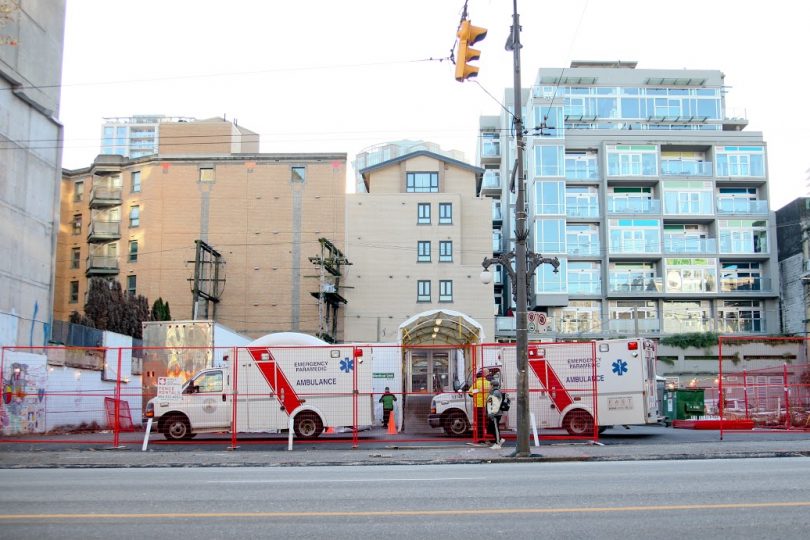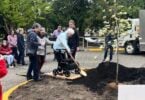Marilyn Oberg, Paramedic Chief for BC Emergency Health Services (BCEHS), recalls responding to as many as 20 overdose calls in one shift as early as 2014. Today, a paramedic may receive upwards to 100 overdose calls in a day.
With the recent news about the opioid overdose deaths pushing down life expectancy in BC and putting first responders under immense stress, we sat with Marilyn Oberg, Paramedic Chief at BC Emergency Health Services (BCEHS), to talk about the realities of the overdose crisis for our paramedics and the public.

Question: What happens when you call 911 about an overdose?
Marilyn: As soon as you call 911, you’ll be deferred to our dispatch system. Our first key step however is to coach that person through and apply the resources that we can use to aid the situation.
Question: What are some questions that a caller can expect during the phone call?
Marilyn: When you’re calling 911, we understand that you’re in a terrible predicament. Usually, the person is very scared. Whether it’s the patient themselves calling or a family member calling, there’s a huge concern and it’s a terrible moment for them. So, the process that we have set in place is to coach the person in the situation, which is the first part of the response. It’s a huge first step and a key step because the call-taker is going to talk to you on the phone and hold you on the phone and get all the appropriate information like your location.
Actually, this is one of our biggest problems: finding people. Because the caller may be a third party or they may be calling from a different location, it’s difficult to locate the patient. So there are very set questions that the dispatcher will ask you and walk you through to get their location.
A dispatcher may ask you questions, such as:
- Where’s your location?
- Who are you with?
- Are there any dangers?
- Is the patient alert?
- Is the patient breathing normally?
Question: What should you do if you’re unsure about calling 911 and what are some signs that a person is in critical situation?
Marilyn: As a member of the public, calling 911 and expressing a genuine concern is absolutely valid. If, however, you’re unsure about a certain situation, there’s the ability to enroll the people around you for help by asking a question: “Hey, have you seen this person move?”
Also, if you’re able to have a visual cue of their face, and they look inherently unwell, call 911.
Other symptoms and signs may include:
- Ashen or greyish skin tone
- Unresponsive
- Altered breathing
Question: Why do you think there’s a certain amount of anxiety when calling 911?
Marilyn: It’s perfectly normal to feel nervous. You’re making a call from your private life where your attention was on something else. Rest assured that everyone who calls is not very good at it.
Another point that I think is important is that if you’re a patient, and you’ve met a paramedic, you know how we’re going to talk to you and you know that we’re going to help you. In a way, we’re here to say that the dispatchers and paramedics are going to listen to you and they’re going to direct you and they’re going to reach out in the best way they can but it’s also important to remember that we’re all human and we’re all trying our best to render aid to someone who needs it most. So if you’re feeling worried, take a deep breath and know that you’re talking to a friend.
Question: When the paramedics arrive, what are the first steps?
Marilyn: The first five steps to any response is universal.
- Assess the safety and/or risks.
- Make sure the caller, patient and bystanders are safe.
- Block the situation for safety, privacy and medical reasons.
- Perform an assessment of the patient and move to intervention.
- Treat the patient and perform medical care.
The safety of the patient, the bystander and community are put as top priority as well as the privacy and dignity of the patient.
Question: How can the public help and be proactive in light of the overdose crisis?
Marilyn: I think we each need to look at how we participate as a community. It’s nice to feel like you belong to a community, no matter how you look or how you’re dressed. Everybody belongs to somebody and they deserve the respect of being a person.
Even if someone looks a certain way, there’s no harm in being kind. You would be amazed by how a simple “Hi, how’s it going” makes a difference.
Little kindness goes a long way and I think we can all take a simple step to be compassionate. If you set that example, then the next person will take to that and be able to pay it forward.
Learn more about how the BC Emergency Health Services team and Vancouver paramedics here.
Source: http://www.bcehs.ca/health-info/public-health/responding-to-an-overdose
This interview has been edited for brevity and clarity.





